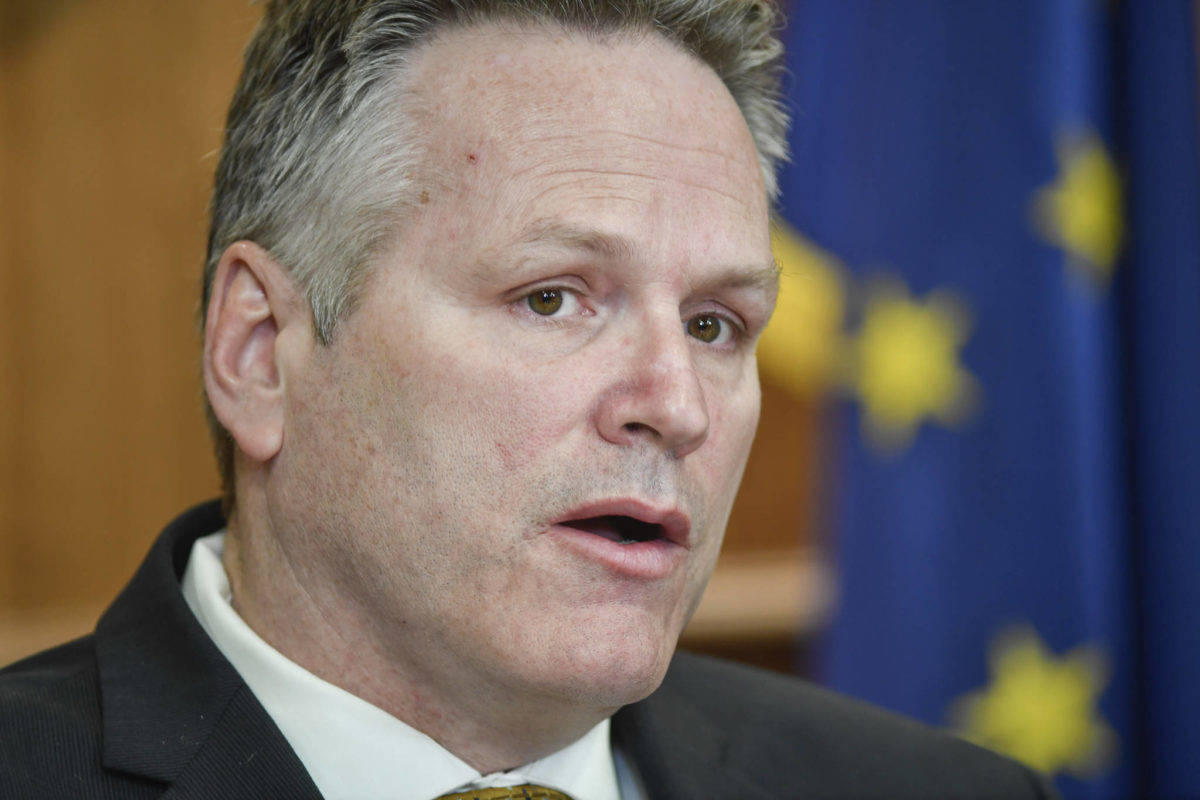Gov. Mike Dunleavy has declared a public health disaster emergency in order to prepare the state for what he said is the inevitable arrival of the novel coronavirus in Alaska.
Dunleavy made the declaration last Wednesday morning, and it coincides with the World Health Organization’s declaration of COVID-19 as a global pandemic. Dunleavy’s declaration initiates a “unified command structure” between several state departments: the Alaska Department of Health and Social Services (DHSS), Alaska Department of Military and Veterans Affairs (DMVA), and the Department of Public Safety (DPS), in order to better tackle the issue.
Through the declaration, the DHSS commissioner is also able to utilize state statutes related to isolation and quarantine. The move also makes it easier for the commissioner to buy needed supplies, hire temporary staff and have better access to disaster relief funds, according to a press release from the governor’s office.
For its part, the Alaska Legislature approved House Bill 206, which appropriates $4.1 million in state money and releases $9 million in federal funding to help prepare for the virus.
At a Tuesday press conference, Chief Medical Officer Anne Zink announced three new confirmed positive cases of COVID-19, bringing the state total to six. As of Tuesday, there are 400 confirmed negative cases in Alaska.
In an interview with the Homer News over the phone last Wednesday, Dunleavy said efforts to ramp up preparedness statewide have been ongoing since January, and this declaration is a natural progression. He called his declaration a necessary tool that needed to be added to Alaska’s toolbox, in order to fight “what we believe is an inevitability.”
According to the Centers for Disease Control, the U.S. has 7,038 confirmed cases as of March 17. There have been a total of 97 deaths from the disease so far in the country.
The U.S. State Department is advising that people, especially those with underlying health conditions, do not travel via cruise ships. Dunleavy said Alaska has a little more time to figure out what that will mean for its summer cruise tourism industry compared to the cruise industry in the Lower 48. Alaska’s cruise season starts up around the end of April, he said.
Dunleavy said Alaska anticipates 367 cruise ship visits this year. He said the state will need to develop an effective screening method to use on passengers.
Alaska will need to work with the cruise industry to make sure vessels have enough personnel and supplies onboard to deal with potential issues on the ships, and that the state will need the ability to stop and check individuals disembarking cruise ships if necessary.
The administration is already working with the cruise ship industry on this, Dunleavy said, and announcements about how the state will deal with the summer cruise ship season will be coming out in the future.
However, after Dunleavy’s interview, Holland America, Viking Cruises and Princess Cruises all announced they are suspending operations.
While the administration is currently advising social distancing for people who are at higher risk of contracting the disease — the elderly and those with a history of things like heart or lung disease — Dunleavy said the administration will make mandates in the future if it has to. On Tuesday, Dunleavy announced a health mandate closing all dine-in service at food establishments and closing bars and breweries to on-site consumption. Restaurants and cafes can still serve food for take-out.
Currently, those at higher risk for contracting the disease are advised to avoid places with large crowds, and to avoid shaking hands or being within 6 feet of another person. If you don’t feel well, don’t leave the house, Dunleavy said.
Dunleavy had been scheduled to visit Kenai, Homer and Seward on the Kenai Peninsula this week, and postponed those town halls because of ongoing developments with coronavirus. Had he been able to be in Homer as scheduled on March 11, Dunleavy said he wanted to hear from community members primarily about the budget and the state’s fiscal situation. He also was hoping to hear from Homer area residents about issues that are important to them, or new and creative ideas about how the state can bring in more revenue.
“It was to hear what suggestions folks all across the state have regarding the budget,” Dunleavy said of the canceled meetings. “Are there areas they feel that we can reduce? Are there revenue options that they favor?”
Oil prices started plummeting last Friday and continued dropping over the weekend, with a barrel of North Slope crude priced at $44.73 on Friday, down $4.75 from the day before, the Anchorage Daily News reported. A longterm drop in the price of oil could cause a significant deficit in the state budget.
Dunleavy said last Wednesday that conversations with the Legislature the last few days have been taken up by COVID-19 and how to prepare for it, but that conversations about the state’s fiscal situation will need to be addressed soon.
“We will have those discussions as to how we’re going to close that gap,” Dunleavy said.
Asked whether the drop in oil prices paired with the overall state of Alaska’s finances might make him consider introducing revenue generating measures sooner than he planned on as governor, Dunleavy said there will be a time and place for revenue “when we get to the point that we can no longer reduce the budget and there’s still a gap.”
Asked which source of generating revenue he would prefer if it came time to introduce one, he said “the least painful.”
Reach Megan Pacer at mpacer@homernews.com.


